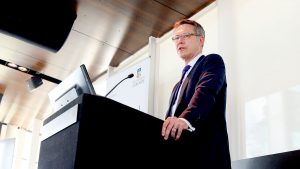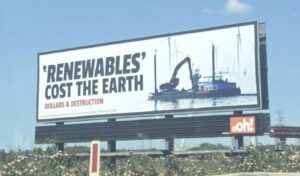As depicted by modellers ACIL-Allen, the biggest failing of the National Energy Guarantee is the projection that there will be no new investment, other than behind the meter, between 2022 and 2030.
Either this projection is flat out wrong, in which case the entirety of the modelling must be rejected, or the NEG must be seen as a failure. It proposes just 1 GW – $2bn of new investment in 10 years, and nothing after 2022.
To be clear we regard a policy as an utter failure if it results in no investment for 8 years in a sector with excellent momentum in cost reduction, excellent decarbonisation prospects and where the existing assets are all recognized as being in their twilight hours.
We can at a pinch understand why the Clean Energy Council, which is leaning towards supporting this policy, might choose to ignore this modelling. It doesn’t own it.
Of course the CEC didn’t get any of its own modelling done. That’s a shame because it would have been useful, but perhaps the CEC had more important things to do.
Can the ESB or anyone else be happy with a policy which the ESB’s hand picked modellers say will produce no new investment in generation, other than behind the meter, in 8 years from 2022 to 2030?
Is that really the policy that COAG can settle for? What happened to the investment lead recovery? What about energy security in the face of ageing coal stations?
In fact, it’s almost certain that the modelling is wrong. The way to see this is to use nominal electricity prices rather than real prices. ACIL uses an inflation assumption of 2.5% but presents results in real $.
We have inflated their price projections at 2%, ie less than the ACIL assumption
In nominal $ in the no NEG case ACIL-Allen forecast a $61/MWh in 2025. There will surely be investment in wind at a $61/MWh price. We have already in 2017 and 2018 seen several wind farms financed at sub $60/.MWh.
These transactions don’t depend on the REC price but represent the underlying LCOE. By 2025 the price will be significantly lower. For instance, Steven Oswald, Country Head in Australia and Commercial Operations Manager in Asia for GE forecasts a $40/MWh 2025 price at this week’s CEC summit.
There simply can be no credibility given to a view that prices around $60/MWh would see no new investment. Surely the ESB must see that.
If the modelling is wrong and obviously wrong, why does the ESB rely heavily on it, as its final submission to COAG states? If the ESB relies heavily on dud modelling how much can COAG rely on ESB judgement?
But perhaps the modelling is irrelevant and it’s all about politics. She’ll be right mate.
Australians and policy makers may be sick of climate wars and debates over climate policy but the issue isn’t going to go away. You are only going to get a real consensus when there is a policy with a realistic decarbonisation goal in line with Australia’s broader commitments, and the underlying need to replace the coal fired stations.
Even then climate change will be a front of mind issue, but in electricity we can have progress.
By the way, when did we get from 26-28% to just 26%? As recently as when the ISP was released AEMO was still working to 28%.
Spreadsheet released
We will admit that what we perceived as “Agenda driven modelling” predicting a big fall in electricity prices under the NEG using what we saw as unrealistic assumptions did nothing more than weaken confidence in the ESB itself.
We note the broad support for the efforts of the ESB, the enormous workload they have shouldered, although certainly no greater than that of AEMO and the AEMC, in these changing times and the goodwill that actually does seem to broadly exist.
What the spreadsheet shows
We show again the price forecasts except we converted them to nominal $ using a 2% inflator and also show NSW baseload futures.

Real prices are a useful analytic tool but in the real world most things are done in nominal $. The price jump in 2030 is due to a QLD power station closing.
Its easy enough to understand that prices under both the NEG and no policy cases will decline as a result of lower assumed coal costs (common to both cases) and the already committed new investment (common to both cases).
Coal costs might not decline of course, and for that matter the Queensland Govt and Victorian Govt might actually achieve their State targets. Lets put those important points to one side.
Therefore we focus on what is driving the incremental price differential.
There can only be three drivers.
- Difference in investment in new capacity between the policy and no policy case. New wind and PV drive out gas and this drops prices. Extra contracting required under the guarantee by coal or gas in order to meet the reliability guarantee.
- This extra contracting has to be dispatched and so it is bid in at SRMC. You also have to then assume that no extra price can be obtainedfor the part of a gentailer’s portfolio that’s not subject to the reliability contracts. Opinions may differ but to me it needs further thinking about.
- The emissions target could require more gas to be produced and less coal towards the end of the period. This will drive up prices. And in fact the modelling does show that.
New investment – or the lack of it
The following figures show the new in front of the meter investment expected under the guarantee and no guarantee cases.


Firstly there is a totally legitimate question about why 1 GW of wind would suddenly get developed if the NEG is passed, when there is no need for it under the emissions trajectory and it will face a terrible price outlook. It should be clear that this extra wind is what drives down cumulative emissions in the NEG case.
That’s because the extra wind being on line from 2021 makes emissions lower for the entire decade. If it was developed more gradually then cumulative emissions and average prices would be higher.
The second issue is whether anyone can really believe that this is what will happen under the policy or no policy scenarios. Reasons to think the scenarios are both equally unlikely are discussed above.
The modelling actually forecasts a 1.7 GW reduction in QLD coal generation in 2030, but doesn’t forecast anything other than rooftop PV being built in front of it. So everyone’s going to get their three year notice of closure and stay on holiday. Actually since all the offices will be closed due to lack of activity in prior years probably no one will be in a position to build anyway.
Should it be renamed the “energy insecurity board” or “reduced security board”
But, but, but the far more important question is whether the ESB can be happy with this outcome?
Last time I looked ESB stood for energy SECURITY board. My emphasis. The coal stations are all getting old and the ESB is happy to die for a policy that will produce no new investment for 8 years other than behind the meter PV? Some security outlook that presents.
Other charts
We show a couple of other charts and note that lower gas generation in the NEG case would contribute to lower prices. We assume the lower gas generation is gas being displaced by the magic extra 1 GW of wind.


David Leitch is principal of ITK. He was formerly a Utility Analyst for leading investment banks over the past 30 years. The views expressed are his own. Please note our new section, Energy Markets, which will include analysis from Leitch on the energy markets and broader energy issues. And also note our live generation widget, and the APVI solar contribution.







